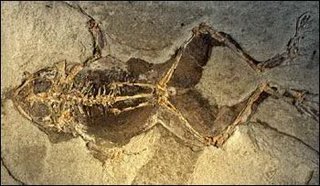Science reporter Helen Briggs
Scientists have extracted marrow from the bones of frogs and salamanders that died 10 million years ago in the muddy swamps of north-eastern Spain. The first fossilised bone marrow known to science provides a rare insight into the make-up of prehistoric animals.
It is preserved in remarkable detail; usually only hard tissue such as bone survives in the fossil record. The soft tissue may yield traces of protein and DNA, researchers report in the journal Geology. Bone marrow is the tissue that fills the centre of large bones, acting as a factory for producing new platelets and red and white blood cells. It contains two types of cells: haematopoietic (which can produce blood cells) and stromal (which can produce fat, cartilage and bone). The ancient bone marrow was preserved in 3D, retaining the original texture and red and yellow colour of haematopoietic and fatty marrow.
"Finding soft tissue like this is so important because it gives an insight into the physiology of ancient organisms, and how their bodies worked," said team member Maria McNamara of University College Dublin,"The fact that we've got red bone marrow in the salamander shows that their blood cells were produced in the bone marrow; in the modern salamander it is not, it is produced in the spleen."
The frogs and salamanders were found in a fossil-rich deposit dating back to the Miocene Epoch, the period of time that extends from about 5.3 to 23 million years ago. Ms McNamara, and colleagues in the UK, Spain and US, say the bone marrow was preserved because the bones acted as a protective shell, preventing microbes from invading and breaking the soft tissue down.
They believe many other examples of preserved bone marrow will be found, raising the possibility of investigating the proteins and DNA of prehistoric animals. "It is very exciting because with this organic material we can look for traces of organic molecules, protein and possibly even DNA," the Dublin researcher said, "There are potentially a lot more of these types of tissue preserved and much more chance for other palaeontologists to find protein and DNA."
The discovery of traces of ancient soft tissue has proved controversial in the past. Many finds have turned out to be little more than mineral deposits. Last year, US researchers extracted some flexible filaments that resembled blood vessels from dinosaur bone. They also found traces of what look liked red blood cells. The bone belonged to a Tyrannosaurus rex specimen that was at least 65 million years old.


No comments:
Post a Comment